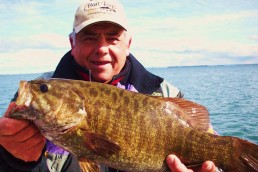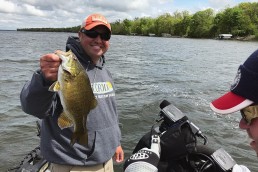Lake Mendota’s Smallmouth Fishery
SHARE THIS POST
The Madison Chain of Lakes has quality fishing with each individual lake having its own “special” species.
The largest lake is 9,842-acre Lake Mendota, and besides having trophy walleyes and large pike, this water has a big smallmouth bass population that’s growing.
Anyone who fishes Lake Mendota should have a quality map and electronics in order to find the abundant mid-lake structure including rock bars and humps, sharp-breaking drop-offs, and the many points that are prime smallmouth locations throughout summer. The minimum size for smallmouths on this lake is 18 inches, but there are many larger fish up to 7 pounds.
Spawning is completed on Mendota by the end of May, and there are keys for fishing the lake for smallmouths. First, look in deep weed edges around this body of water that range from 12 to 20 feet deep. Try anchoring outside the deep weeds and make long casts with a slip float, a 1/16-ounce Slo-Poke jig in Orange and a fat, lively leech. I put the slip-float rod in a holder while casting with another rod. Next, fan-cast with a 1/8-ounce Slo-Poke Weedmaster Jig and a leech or half a nightcrawler. If you don’t like anchoring, try working slowly off your bow-mount trolling motor. I suggest using a 7- to 7 1/2-foot rod for longer casts that won’t spook shallow smallies.
Are you enjoying this post?
You can be among the first to get the latest info on where to go, what to use and how to use it!
As mentioned, other areas to concentrate on are the rock bars and humps located in the main basin and off the numerous points. Smallmouths in Mendota like rock, gravel, and the hard bottoms that attract their favorite food: crayfish. A live-bait rig also works well for fishing the outsides the weeds and up and down the lake’s deeper structure. Put a quality bullet or slip sinker (1/4 ounce) above a barrel swivel, tie on 3 to 4 feet of fluorocarbon line, and then use a colored hook or floating jig head baited with a leech or a piece of nightcrawler. This rig can be slowly dragged up and down breaks, up and over the rocks and along the bottom. PowerBaits, tubes and ringworms should be in your arsenal too.
Here are additional prime smallmouth areas on Lake Mendota.
- Try fishing the deep weed edges on both sides of Picnic and Second points, Governors Island and off Maple Bluff.
- Work the rock bars and humps north of the Brearly Street Bar on the east side of the lake. There are rocks, weeds and numerous inside and outside turns with some open pockets to cast.
- Dunn’s Bar just out from Governors Island is another location. Cast slip floats and leeches up to the rocks, weeds and bar edges. Drag jigs up and down the many steep breaks for smallmouths.
- There is some structure north of Second Point where the depths and contours change rapidly from 20 to 40 feet. Try fishing the sharp contours with a jig or a live-bait rig.
- West of Second Point is the Commodore Bar, which tops off at 15 feet and drops down to 60 feet. Use your electronics to see if fish are present on the bar. Either jig or rig the fish.
Spinnerbaits, buzzbaits and inline spinners will work when burned across the weed tops. The noise, flash and vibration attract the bass buried in the weeds or the ones cruising the edges. White and black spinners with gold and silver blades are my favorites for Mendota.
MWO
SHARE THIS POST
Did you enjoy this post?
You can be among the first to get the latest info on where to go, what to use and how to use it!
Gary Engberg
If you have any questions or comments you may reach Gary Engberg at 608-795-4208 or garyengbergoutdoors.com.



